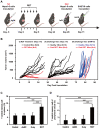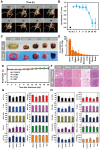Low-dose X-ray radiodynamic therapy solely based on gold nanoclusters for efficient treatment of deep hypoxic solid tumors combined with enhanced antitumor immune response
- PMID: 36793856
- PMCID: PMC9925321
- DOI: 10.7150/thno.78649
Low-dose X-ray radiodynamic therapy solely based on gold nanoclusters for efficient treatment of deep hypoxic solid tumors combined with enhanced antitumor immune response
Abstract
Background: Radiodynamic therapy (RDT) is an emerging novel anti-cancer treatment based on the generation of cytotoxic reactive oxygen species (ROS) at the lesion site following the interaction between low-dose X-ray and a photosensitizer (PS) drug. For a classical RDT, scintillator nanomaterials loaded with traditional PSs are generally involved to generate singlet oxygen (1O2). However, this scintillator-mediated strategy generally suffers from insufficient energy transfer efficiency and the hypoxic tumor microenvironment, and finally severely impedes the efficacy of RDT. Methods: Gold nanoclusters were irradiated by low dose of X-ray (called RDT) to investigate the production of ROS, killing efficiency of cell level and living body level, antitumor immune mechanism and biosafety. Results: A novel dihydrolipoic acid coated gold nanoclusters (AuNC@DHLA) RDT, without additional scintillator or photosensitizer assisted, has been developed. In contrast to scintillator-mediated strategy, AuNC@DHLA can directly absorb the X-ray and exhibit excellent radiodynamic performance. More importantly, the radiodynamic mechanism of AuNC@DHLA involves electron-transfer mode resulting in O2 -• and HO•, and excess ROS has been generated even under hypoxic conditions. Highly efficient in vivo treatment of solid tumors had been achieved via only single drug administration and low-dose X-ray radiation. Interestingly, enhanced antitumor immune response was involved, which could be effective against tumor recurrence or metastasis. Negligible systemic toxicity was also observed as a consequence of the ultra-small size of AuNC@DHLA and rapid clearance from body after effective treatment. Conclusions: Highly efficient in vivo treatment of solid tumors had been achieved, enhanced antitumor immune response and negligible systemic toxicity were observed. Our developed strategy will further promote the cancer therapeutic efficiency under low dose X-ray radiation and hypoxic conditions, and bring hope for clinical cancer treatment.
Keywords: antitumor immune; gold nanoclusters; radiodynamic therapy; solid tumor.
© The author(s).
Conflict of interest statement
Competing Interests: The authors have declared that no competing interest exists.
Figures








Similar articles
-
Treating Deep-Seated Tumors with Radiodynamic Therapy: Progress and Perspectives.Pharmaceutics. 2024 Aug 28;16(9):1135. doi: 10.3390/pharmaceutics16091135. Pharmaceutics. 2024. PMID: 39339173 Free PMC article. Review.
-
NaCeF4:Gd,Tb Scintillator as an X-ray Responsive Photosensitizer for Multimodal Imaging-Guided Synchronous Radio/Radiodynamic Therapy.Nano Lett. 2019 Nov 13;19(11):8234-8244. doi: 10.1021/acs.nanolett.9b03682. Epub 2019 Oct 8. Nano Lett. 2019. PMID: 31576757
-
Super-efficient in Vivo Two-Photon Photodynamic Therapy with a Gold Nanocluster as a Type I Photosensitizer.ACS Nano. 2020 Aug 25;14(8):9532-9544. doi: 10.1021/acsnano.9b05169. Epub 2019 Nov 4. ACS Nano. 2020. PMID: 31670942
-
Mitochondria-Targeted Nanosystem Enhances Radio-Radiodynamic-Chemodynamic Therapy on Triple Negative Breast Cancer.ACS Appl Mater Interfaces. 2023 May 10;15(18):21941-21952. doi: 10.1021/acsami.3c02361. Epub 2023 Apr 26. ACS Appl Mater Interfaces. 2023. PMID: 37099714
-
Recent Progress and Trends in X-ray-Induced Photodynamic Therapy with Low Radiation Doses.ACS Nano. 2022 Dec 27;16(12):19691-19721. doi: 10.1021/acsnano.2c07286. Epub 2022 Nov 15. ACS Nano. 2022. PMID: 36378555 Review.
Cited by
-
Combination of bacterial-targeted delivery of gold-based AIEgen radiosensitizer for fluorescence-image-guided enhanced radio-immunotherapy against advanced cancer.Bioact Mater. 2023 Aug 22;30:200-213. doi: 10.1016/j.bioactmat.2023.05.010. eCollection 2023 Dec. Bioact Mater. 2023. PMID: 37663305 Free PMC article.
-
Advances in Nanodynamic Therapy for Cancer Treatment.Nanomaterials (Basel). 2024 Apr 8;14(7):648. doi: 10.3390/nano14070648. Nanomaterials (Basel). 2024. PMID: 38607182 Free PMC article. Review.
-
Nanomaterials-Induced Redox Imbalance: Challenged and Opportunities for Nanomaterials in Cancer Therapy.Adv Sci (Weinh). 2024 Apr;11(16):e2308632. doi: 10.1002/advs.202308632. Epub 2024 Feb 21. Adv Sci (Weinh). 2024. PMID: 38380505 Free PMC article. Review.
-
Treating Deep-Seated Tumors with Radiodynamic Therapy: Progress and Perspectives.Pharmaceutics. 2024 Aug 28;16(9):1135. doi: 10.3390/pharmaceutics16091135. Pharmaceutics. 2024. PMID: 39339173 Free PMC article. Review.
-
Recent advances in the development of tumor microenvironment-activatable nanomotors for deep tumor penetration.Mater Today Bio. 2024 Jun 8;27:101119. doi: 10.1016/j.mtbio.2024.101119. eCollection 2024 Aug. Mater Today Bio. 2024. PMID: 38966042 Free PMC article. Review.
References
-
- Dolmans DE, Fukumura D, Jain RK. Photodynamic therapy for cancer. Nat Rev Cancer. 2003;3:380–7. - PubMed
-
- Li X, Lovell JF, Yoon J, Chen X. Clinical development and potential of photothermal and photodynamic therapies for cancer. Nat Rev Clin Oncol. 2020;17:657–74. - PubMed
-
- Hu J, Tang Ya, Elmenoufy AH, Xu H, Cheng Z, Yang X. Nanocomposite-based photodynamic therapy strategies for deep tumor treatment. Small. 2015;11:5860–87. - PubMed
-
- Fan W, Huang P, Chen X. Overcoming the Achilles' heel of photodynamic therapy. Chem Soc Rev. 2016;45:6488–519. - PubMed
Publication types
MeSH terms
Substances
LinkOut - more resources
Full Text Sources

